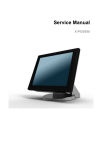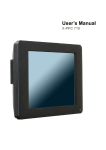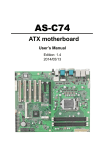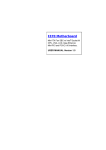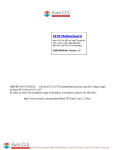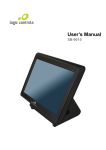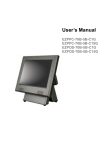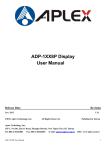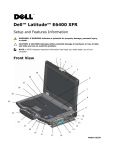Download XPOS 950 User Manual 20111205
Transcript
User’s Manual X-POS950 Copyrights ©2011 All rights reserved. The information in this document is subject to change without prior notice in order to improve reliability, design and function and does not represent a commitment on the part of the manufacturer. This document contains proprietary information protected by copyright. All rights are reserved. No part of this manual may be reproduced by any mechanical, electronic, or other means in any form without prior written permission of the manufacturer. All trademarks are property of their respective owners Liability Disclaimer In no event will the manufacturer be liable for direct, indirect, special, incidental, or consequential damages arising out of the use or inability to use the product or documentation, even if advised of the possibility of such damages. Regulatory Information CE mark compliance This device complies with EMC Directive 2004/108/EC issued by the Commission of the European Community. Warning: This a Class B product. In a domestic environment this product may cause radio interference, in which case the user may be required to take adequate measures Safety Statement for Lithium Battery I Contents Copyrights............................................................................................................... I Liability Disclaimer................................................................................................. I Regulatory Information .......................................................................................... I CE mark compliance .................................................................................... I Safety Statement for Lithium Battery.......................................................... I Contents ................................................................................................................. II 1. Hardware Setup ................................................................................................. 1 1.1. Packing Contents.................................................................................. 1 1.2. Quick Tour ............................................................................................. 2 Front View and Rear View .................................................................... 2 Back Panel I/O....................................................................................... 2 1.3. Basic Peripherals Installation .............................................................. 3 Power Adapter ...................................................................................... 3 Computer Mouse and Computer Keyboard........................................ 3 USB ODD ............................................................................................... 4 LAN Cable ............................................................................................. 4 Cash Drawer.......................................................................................... 4 Customer Display ................................................................................. 4 MSR........................................................................................................ 8 2nd Display ......................................................................................... 10 1.4. Turn on the device .............................................................................. 20 2. RAID Configuration ......................................................................................... 21 2.1. For Microsoft Windows XP................................................................. 29 2.2. For Microsoft Windows Embedded POSReady................................ 32 2.3. For Microsoft Windows 7 ................................................................... 35 3. Basic Driver Installation.................................................................................. 36 3.1. Before the installation ........................................................................ 36 3.2. Chipset Software Installation ............................................................. 36 3.3. VGA Driver Installation ....................................................................... 38 3.4. Touch Screen Driver and Software Utility installation ..................... 40 3.5. LAN Driver Installation ....................................................................... 42 3.6. Audio Driver Installation..................................................................... 44 4. eGalaxy Touch Control Utility Quick Guide................................................... 45 4.1. Launch eGalaxy Touch Control Utility .............................................. 45 4.2. General ................................................................................................ 45 4.3. Settings................................................................................................ 48 4.4. Tools .................................................................................................... 51 4.5. Edge Compensation ........................................................................... 53 4.6. How to Use Event Selector ................................................................ 55 II 5. I/O Definition .................................................................................................... 56 5.1. Power Connector ................................................................................ 56 5.2. Serial Port............................................................................................ 56 5.3. Cash Drawer........................................................................................ 57 6 Specification ..................................................................................................... 58 III 1. 1. Hardware Setup 1.1. Packing Contents 1. X-POS950 X 1 4. Drive and Utility DVD X 1 2. Power Adapter X 1 5. Cable Cover X 1 3. Power Cord X 1 Chapter 1 1 1.2. Quick Tour Front View and Rear View LED Indicator The Power indicator will glow green when power is on. The HDD indicator will blink green when the HDD is accessed. The LAN indicator will blink green when transferring data though the LAN. Back Panel I/O 2 Chapter 1 1.3. Basic Peripherals Installation 1. All cables and wires from peripherals to the POS device are recommended to be fed through the base in the direction as shown below. WARNING: Before the cable cover is removed, please make sure the power is off! Power Adapter Connect the DC cable to the DC in jack. Computer Mouse and Computer Keyboard Connect your computer mouse and keyboard to USB 1/2, UBS 3/4 or the KB/MS port, depends on which type of computer mouse/keyboard used. Chapter 1 3 USB ODD Connect your USB ODD to USB 1/2 or UBS 3/4 port. LAN Cable Connect one end of RJ-45 LAN cable to the LAN 1 or LAN 2 port on the back panel of the device, another end to your internet device. Cash Drawer Connect one end of RJ-11 cable to the Cash Drawer port on the back panel of the device, another end to your cash drawer. Customer Display A. Hardware Installation 1. Remove the two screws fixing the customer display cover and then remove the cover. 4 Chapter 1 2. Adjust the hinge of the customer display, and then connect to the device as shown below. 3. Mount the customer display to the device and tighten the two M3 screws as shown below. 4. Finished. Chapter 1 5 B. Customer Display Power Supply Configuration Caution: Never enable the power supply without the customer display installed and be sure to disable the power supply before removing the customer display. 1. Power up the X-POS950, and press the DEL key to enter BIOS before the Windows screen appear. 2. Under BIOS screen, use the or key on your computer keyboard to move to the Advanced tab, and then use the or key on your computer keyboard to select Super IO Configuration then press ENTER key. 6 Chapter 1 3. Use the or ENTER key. key to highlight the Serial Port 6 Configuration, and the press 4. Use the Use the key to select the COM Voltage, and the press ENTER key. key to highlight 12V and press ENTER key. Chapter 1 or or 7 5. Press F10 key, highlight Yes and press ENTER key. MSR 1. Remove the two screws fixing the MSR cover. 2. Remove the MSR cover from the device. 8 Chapter 1 3. Connect the connectors of the MSR assembly to the device. 4. Tighten the two M3 screws to fix the MSR assembly as shown below. 5. Finished. Chapter 1 9 2nd Display Before installation, make sure that the all item listed below are ready. Base Type 2nd Display Kit: A. 2nd Display (12” or 15”) F. base bracket B. 2nd display base G. M3 screw X 4 C. 2nd display support H. M4 screw X 2 D. Plastic bush I. VGA Cable E. Plastic spacer Pole Type 2nd Display Kit: A. 2nd Display (8.4” or 10”) G. base bracket B. 2nd Display Mount H. Plastic spacer C. 2nd display support I. M3 screw X 4 D. 2nd display base J. M4 screw X 2 E. Plastic pole (long) K. USB Cable (for USB type 2nd Display only) F. Plastic pole (short) L. VGA Cable (for VGA type 2nd Display only) 10 Chapter 1 Base Type 2nd Display Kit Installation: 1. Install the 2nd display base (item B.) onto the X-POS950 by M4 screw X 2 (Item H.) as shown. 2. Insert the plastic bush into the base as shown. 3. Feed the blue connector of the VGA cable (item I.) through the base of the device as shown below. 4. Remove the film on the back of the plastic spacer (item E.); and then stick the spacer to the base bracket (item F.) as shown. Feed the blue connector of the VGA cable (item I.) through the base bracket. Chapter 1 11 5. Connect heads of all the cables to the ports of the back I/O panel of the POS device. 6. Feed the black head (with power connector) of the VGA cable through the 2nd display support (item C.). 7. Connect the black head (with power connector) and the power connector of the VGA cable to the VGA port and power input jack of the back I/O panel of the 2nd display, and then tighten the four M3 screws to fix the 2nd display support onto the 2nd display as shown below. 8. Insert the 2nd display onto the base of the device. 12 Chapter 1 9. Push the base holder bracket into the base, and then tighten the two M4 screws to fix the 2nd display. 10. Install the IO panel cover onto the device. 11. Finished. Now you can adjust the horizontal angle of the 2nd display. Chapter 1 13 Pole Type 2nd Display Kit Installation: 1. Install the 2nd display base (item D.) onto the X-POS950 by M4 screw X 2 (Item I.) as shown. 2. Insert the plastic bush into the base as shown. 3. Feed the Type A USB connector of the USB cable (item K.) or the blue connector of the VGA cable (item L.) through the base of the device as shown below. 4. Remove the film on the back of the plastic spacer (item H.); and then stick the spacer to the base bracket (item G.) as shown. Feed the Type A USB connector of the USB cable (item K.) or the blue connector of the VGA cable (item L.) through the base bracket. 14 Chapter 1 5. Connect the Type A USB connector of the USB cable (item K.) or the blue connector of the VGA cable (item L.) to the ports of the back I/O panel of the POS device. 6. Push the base holder bracket into the base, and then tighten the two M4 screws to fix the 2nd display. 7. Feed the Type B USB connector of the USB cable (item K.) or the black connector of the VGA cable (with power connector) (item L.) through plastic poles (item E. and F.) and install the plastic poles as shown below. Chapter 1 15 8. Feed the Type B USB connector of the USB cable (item K.) or the black connector of the VGA cable (with power connector) (item L.) through the 2nd Display Mount (item B.). 9. Connect the Type B USB connector of the USB cable (item K.) or the black connector of the VGA cable (with power connector) (item L.) to the proper port of the back I/O panel of the 2nd display, and then tighten the four M3 screws to fix the 2nd display mount onto the 2nd display as shown below. 16 Chapter 1 10. Install the 2nd display assembly as shown. 2nd Display Power Supply Configuration 1. Power up the X-POS 950, and press the DEL key to enter BIOS before the Windows screen appear. Chapter 1 17 2. Under BIOS screen, use the or key on your computer keyboard to move to the Advanced tab, and then use the or key on your computer keyboard to select Video Function Configuration then press ENTER key. 3. Use the key. 18 or key to highlight the VGA Power +12, and the press ENTER Chapter 1 4. Use the or key to highlight Enabled and press ENTER key. 5. Press F10 key, highlight Yes and press ENTER key. Chapter 1 19 1.4. Turn on the device 1. Make sure all peripherals are connected properly. 2. Press and hold the power switch until the power indicator on the front panel glows green. 3. Install the cable cover. 20 Chapter 1 2. 2. RAID Configuration RAID configuration must be done before the Windows operating system (Windows 7 excluded) installation. Before the steps below starts, make sure that an external USB DVD-ROM drive with the Windows installation disc loaded, an external USB floppy disc drive and other accessories are all connected to the X-POS 950 properly. 1. On a personal computer, insert the Driver and Utility DVD into the DVD-ROM drive and insert a 3.5” floppy into the floppy disk. 2. On the DRIVER BANK screen, click X-POS 950 Series to enter the driver selection screen. 3. On the driver selection screen, click SATA/ AHCI/ RAID Driver. Chapter 2 21 4. Click AHCI/RAID Driver for DOS. 5. A Windows Explore window pops-up. There are two folders: “RAID_F6_32bit_10.1.0.1008_PV” and “RAID_F6_64bit_10.1.0.1008_PV”. Copy a folder into the floppy disc according to the Windows operating system you choose to install. 6. Eject the 3.5” floppy disk and insert it into the USB floppy disk drive which is connected to the X-POS 950. 22 Chapter 2 7. Power up the X-POS 950, and press the DEL key of the external computer keyboard to enter BIOS before the Windows screen appear. 8. Under BIOS screen, use the or key on your external computer keyboard to move to the Advanced tab, and then use the or key on your computer keyboard to highlight SATA Configuration and then press the ENTER key. Chapter 2 23 9. Under Advance tab, highlight SATA Mode and then press the ENTER key of the external computer keyboard. 10. Select RAID Mode or AHCI Mode according to your application, and then press the ENTER key of the external computer keyboard. 24 Chapter 2 11. Press the F10 key of the external computer keyboard, select Yes and then press the ENTER key of the external computer keyboard. 12. The screen below shows, press the CTRL key and I key of the external computer keyboard simultaneously. Chapter 2 25 13. Under the MAIN MENU, select Create RAID Volume and then press ENTER key of the external computer keyboard. 14. Under the CREATE VOLUME MENU, highlight the item Name to specify the volume name. 26 Chapter 2 15. Highlight the item RAID Level to specify the RAID type (RAID0 or RAID1). 16. Back to the MAIN MENU, select EXIT and then press ENTER key of the external computer keyboard. Chapter 2 27 17. Press Y key of the external computer keyboard and then press F11 key to enable the system to reboot by external optical disk drive. 18. The screen below shows and then switches to the Windows installation automatically. Steps below are variable based on the OS you had chosen. 28 Chapter 2 2.1. For Microsoft Windows XP Steps described below are for Microsoft Windows XP series. 1. Press the F6 key of the external computer keyboard as soon as the message on the gray bar shows. 2. Press S key. Chapter 2 29 3. If “RAID Mode” is selected under the SATA Configuration in BIOS: Use the or key to select Intel (R) Desktop/Workstation/Server Express Chipset SATA RAID Controller. If “AHCI Mode” is selected under the SATA Configuration in BIOS: Use the or key to select Intel (R) Desktop/Workstation/Server Express Chipset SATA AHCI Controller. 30 Chapter 2 4. Press S key to continue. 5. Setup is loading files. Chapter 2 31 6. 7. Repeat Step 2, Step 3 and Step 4. Press ENTER key to continue Windows XP installation. 2.2. For Microsoft Windows Embedded POSReady Steps described below are for Microsoft Windows Embedded POSReady series. 1. When the message on the gray bar shows, press the F6 key of the external computer keyboard. 32 Chapter 2 2. Press ENTER key. 3. If “RAID Mode” is selected under the SATA Configuration in BIOS: Use the or key to select Intel (R) Desktop/Workstation/Server Express Chipset SATA RAID Controller. Chapter 2 33 If “AHCI Mode” is selected under the SATA Configuration in BIOS: Use the or key to select Intel (R) Desktop/Workstation/Server Express Chipset SATA AHCI Controller. 4. Press ENTER key to continue. 34 Chapter 2 5. On the screen below, select Install Third-Party Storage Drivers. Click Next to continue rest steps of Microsoft Windows Embedded POSReady installation. 2.3. For Microsoft Windows 7 There is not any special configuration or setting for RAID during Microsoft Windows 7 installation. Chapter 2 35 3. 3. Basic Driver Installation 3.1. Before the installation 1. Connect an external USB CDROM to the USB port and insert the Driver and Utility DVD and turn on the device. The program autoruns and displays the DRIVER BANK screen. 2. On the DRIVER BANK screen, click XPOS 950 Series to enter the driver selection screen. 3.2. Chipset Software Installation 1. On the driver selection screen, click INTEL Chipset Driver. 36 Chapter 3 2. Click Next. 3. Read the License Agreement carefully and click Yes. 4. Click Next. 5. Click Finish. Chapter 3 37 3.3. VGA Driver Installation 1. On the driver selection screen, click VGA Driver. 2. Click VGA Driver for Windows XP. 3. Click Next. 4. Read the License Agreement carefully and click Yes. 38 Chapter 3 5. Click Next. 6. Click Next. 7. Select restart your computer right now or later, and then lick Finish. Chapter 3 39 3.4. Touch Screen Driver and Software Utility installation 1. On the driver selection screen, click Touch Panel Driver. 2. Click Touch Panel Driver For Windows. 3. Click Next. 40 Chapter 3 4. The Install RS232 interface driver box is checked as default, click Next. 5. Click the OK button on the message box. 6. Check any box according to your needs, and then click OK. 7. The driver and program will be installed automatically. Chapter 3 41 8. Select an item according to your needs, and then click Next. 3.5. LAN Driver Installation 1. On the driver selection screen, click LAN Drive. 2. Click RTL8111C Driver For XP. 3. Click Next. 42 Chapter 3 4. Click Next. 5. The driver will be installed automatically. 6. Click Finish. Chapter 3 43 3.6. Audio Driver Installation 1. On the driver selection screen, click HD Audio Driver. 2. Click Next. 3. The driver and program will be installed automatically. 4. Select an item according to your needs, and then click Next. 44 Chapter 3 4. 4. eGalaxy Touch Control Utility Quick Guide 4.1. Launch eGalaxy Touch Control Utility Under Microsoft Windows Embeded, click “Start” menu and select “All Programs”, under ”eGalaxy Touch” menu, click “TouchMon”. 4.2. General The General tab in eGalaxy Touch shows all of TouchMon touchscreen controllers installed as below, including RS232, USB and PS2 interfaces. Chapter 4 45 Add The function button is used for serial RS232 controllers only. Press this button to search the TouchMon serial controllers connected with the COM ports of the device. Whenever it finds a new TouchMon serial controller, a new serial controller icon object will be shown in the controller list window automatically. USB TouchMon device supports plug and play, the icon object for USB controller will be shown in the controller list window automatically when the USB controller is connected with the USB port of the device. And, the icon object for the USB controller will disappear automatically as soon as the device was removed from the USB port of the device. TouchMon PS2 driver support PS2 mouse and TouchMon touchscreen controller. It can works with both PS2 mouse and TouchMon touchscreen PS2 controller. After the TouchMon PS2 driver was installed, this utility assumes the PS2 touchscreen controller exists and is always shown in the controller list window. Remove This function button is used for serial RS232 controllers only. This button will be grayed and disabled automatically when the selected controller in the controller list window is not RS232 type. Press to remove and uninstall the selected serial RS232 controller from the device. Then, this serial RS232 icon object in controller list window disappears automatically. USB TouchMon device supports plug and play, the icon object for USB controller will be shown in the controller list window automatically when the USB controller is connected with the USB port of the device. And, the icon object for the USB controller will disappear automatically as soon as the device was removed from the system USB port. 46 Chapter 4 TouchMon does not allow you to remove/uninstall the PS2 device driver dynamically. To uninstall the TouchMon PS2 driver, you need to go to Windows Device Manager to do un-installation. In addition, after PS2 un-installation, it needs to reboot the device to complete un-installation. Monitor Mapping This function is to define the primary touchscreen display when external touchscreen display is connected. The first touchscreen display (including the onboard 15” touchscreen) where you run this function first will be set as the primary one. On the touchscreen display you want to set as the primary, launch the eGalaxy Touch and click the Monitor Mapping button under the General tab. The screen below will show, the character “1” means “primary” (“2” means secondary, and so on). Touch the yellow box to switch back to the General tab. Chapter 4 47 4.3. Settings There are function buttons and check boxes in the Settings tab. Beep Beep On Touch Check this check box to enable driver to generate a beep sound when touchscreen state is switched from untouched to touched state. Beep On Release Check this check box to enable driver to generate a beep sound when touchecreen state is switched from touched state to untouched state. Beep From System Beep Check this check box to enable driver to generate a beep sound from the operation system. Beep From Sound Card Check this check box to enable driver to generate a beep sound from the sound card onboard. 48 Chapter 4 Frequency Drag the slider to adjust this frequency to control the beep sound frequency generated by the driver. Duration Drag the slider to adjust this duration to control the beep sound duration. Linearization Style TouchMon provides you with both 9 points and 25 points calibration for linearization. You can select the suitable linearization type. Double Click Time Double Click Time is used to set double click time. Change this value will affects the double click behavior for all of the mouse devices connected to the device. Two continuous clicks at the same area within this specified time period will be recognized as a double click event. Double Click Area Double click area is used to set the double click area. Change this value will affects the double click behavior for all of the mouse devices connected to the device. Two continuous clicks with this specified area in the specified double click time will be recognized as a double click event. Click On Touch Change the emulation mode by pressing on this button. Chapter 4 49 Normal Mode Normal mode behaves mouse button down and mouse move. You can select this mode to select object, and dragging the object. Click On Touch With this Click On Touch mode, the driver emulates a mouse click event when the touchscreen state was switched from un-touched state to touched state. Then, the driver always generate mouse move event and is tracking the touch position until the touchscreen state switched to un-touch state. Click On Release With this Click On Release mode, the driver emulates a mouse click event when the touchscreen state was switched from touched state to un-touched state. Click On Touch without moving cursor With this mode, the driver behaves similar as Click On Touch mode. The cursor does not move to the touch position except the first touch point. Click On Release without moving cursor With this mode, the driver behaves similar as Click On Release mode. The cursor does not move to the touch position except the lift-off point. 50 Chapter 4 Option You can set configuration for some advanced functions with this option button. Press this button, a pop up property sheet window will be popped up and shown as below. 4.4. Tools There are function buttons and check boxes in the Tools tab. Chapter 4 51 4 Points Calibration, Clear and Calibration, and Iinearization button Click the one of three these buttons and follow the instruction on the screen to do the screen calibration. Draw Test After clicking this button, you can do the drawing test by drawing any path on the screen as shown below. You can remove all paths you drew by clicking Clear, or exit this screen by clicking Quit. 52 Chapter 4 4.5. Edge Compensation Edge Compensation property page contains functions of Edge Compensation for Top, Bottom, Left, Right, X Axis and Y Axis. In some cases, if it is difficult to touch items at the edges of the touch panel, you can set adjustment to reach the edges of the screen image. Top If you set the Edge to "Smaller", TouchMon will reduce the horizontal position of the top edge. If you set the Edge to "Larger", TouchMon will extend the horizontal position of the top edge. Bottom If you set the Edge to "Smaller", TouchMon will reduce the horizontal position of the bottom edge. If you set the Edge to "Larger", TouchMon will extend the horizontal position of the bottom edge. Left If you set the Edge to "Smaller", TouchMon will reduce the vertical position of the right edge. If you set the Edge to Chapter 4 53 "Larger", TouchMon will extend the vertical position of the left edge. Right If you set the Edge to "Smaller", TouchMon will reduce the vertical position of the right edge. If you set the Edge to "Larger", TouchMon will extend the vertical position of the right edge. In some cases, cursor will be behind the finger when you touch the panel. If you can not see the cursor when you touch down the panel, you can set X Axis or Y Axis to move the cursor. Offset X Axis If you set the Offset X Axis to Smaller, cursor will be moved a pixel of X Axis to left. If you set the Offset X Axis to Larger, cursor will be moved a pixel of X Axis to right. Offset Y Axis If you set the Offset Y Axis to Smaller, cursor will be moved a pixel of Y Axis to top. If you set the Offset Y Axis to Larger, cursor will be moved a pixel of X Axis to bottom. Edge Compensation Switch You can check Support Edge Compensation check box to enable/disable this function from left corner. Edge Compensation Button Click +10% or -10% button to adjust the smaller or larger of edge. 54 Chapter 4 If you click +10% button, the top, bottom, left and right edges will extend 10% of orientation to touch screen, and cursor will be moved 10 pixel of X and Y Axis to right and top. If you click -10% button, the top, bottom , left and right edges will contract 10% of orientation to touch screen, and cursor will be moved 10 pixel of X and Y Axis to left and bottom. Click Default button to resume to the default value. 4.6. How to Use Event Selector For launching the event selector, right click on the eGalaxy icon on the task bar, and then select Display Button command. 1. On the desktop of Windows, click 2. icon change to icon. . 3. Now the tapping is simulating right mouse button clicking. 4. After one tap on the screen, icon change to . 5. The tapping resumes to left mouse button clicking. Chapter 4 55 5. 5. I/O Definition Please refer the detailed technical information about all I/O ports as followings. 5.1. Power Connector PIN Description PIN Description 1 +19V 3 GROUND 2 +19V 4 GROUND 5.2. Serial Port COM Port PIN Description PIN Description 1 DCD 6 DSR 2 RXD 7 RTS 3 TXD 8 CTS 4 DTR 9 RI / 5V /12V 5 GND PIN R232 RS422 RS485 1 DCD TX- D- 2 RXD TX+ D+ 3 TXD RX+ 4 DTR RX- Chapter 5 56 5.3. Cash Drawer Connector PIN Description PIN Description 1 GND 4 P24V 2 D_OUT0 5 N/C 3 D_IN 6 GND Cash Drawer Control Status Address Value Open 280H Bit 4 = 0 Close 280H Bit 4 = 1 280H Bit 0 = 0/1 Read Status 57 Chapter 5 6. 6 Specification Chapter 5 58 Main Board Chipset Intel® Sandy Bridge LGA1155 Core i7 - 2600 3.4 GHz (TB 3.8GHz) / L3: 8MB / 4 core 8 threads / 95 watt Core i5 - 2400 3.1 GHz (TB 3.4GHz) / L3: 6MB / 4 core 4 threads / 95 watt Core i3 - 2120 3.3 GHz / L3: 3MB / 2 core 4 threads / 65 watt Pentium G850 2.9 GHz / L3: 3MB / 2 core 2 threads / 65 watt Intel® BD82Q67 PCH System Memory 2xDIMM, supported DDR3 1066/1333. up to 8GB per channel OS Windows® XP / WES, POSReady 2009, Windows 7 CPU Display TFT LCD Size 15” Brightness 250 nits , brightness adjustment by BIOS Resolution 1024 x 768 Touch Screen 5-wire Resistive Type Tilt Angle 0°~90° Storage Device HDD Compact Flash 2 x 2.5" Removable HDD Drive Bay , Support RAID 0, 1 function 1 x CFast slot I/O Ports VGA USB LAN 5 x RS-232 COM 1 : RS-232/422/485, DB-9, Pin9 w/ RI/5V/12V Selectable by BIOS COM 2 / 5 : DB-9, Pin9 w/ RI/5V/12V Selectable by BIOS COM 3 : RS232, internal pin header for MSR COM 6 : RS232, internal pin header for Customer Display 1 x DB15, Supported DC12V/1A output. 6 x USB 2.0 (4 x external, 2 x internal) 2 x Gigabit Ethernet by RJ-45 , Support Wake on LAN Cash Drawer 1 x RJ-11 (24 VDC) PS/2 Keyboard / Mouse 1 x Mini-DIN Parallel 1 x DB25 Serial Others Wall mount Support VESA Mount 75x75 / 100x100mm Power Input External adapter,180Watt, 19VDC input Color Material Black Plastic / Aluminum EMC& Safety Compliance FCC / CE / WEEE / RoHS / VCCI Front Panel Protection IP 65 compliance Weight 7.95 Kg (appox.) Dimension 380W x 260D x 315H (mm) Operation Temperature 0°C ~ 40°C Storage Temperature -20°C ~ 60°C Storage Humidity 20% - 90% RH, non-condensing Audio 1.5W Speaker X 1 Chapter 6 59 Optional Accessories Customer display: VFD Attached, 20 columns x 2 lines, RS-232 Type MSR-Front Type, 3 Tracks, PS/2 Type MSR-Side Type, 3 Tracks, PS/2 Type & Finger Print, USB Type MSR-Side Type, 3 Tracks, PS/2 Type & i-Button, PS/2 Type 12.1” 2nd Display Specifications are subject to change without notice. Chapter 5 60

































































